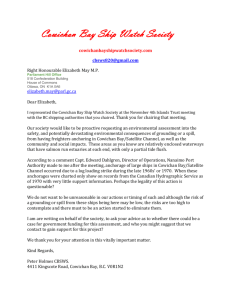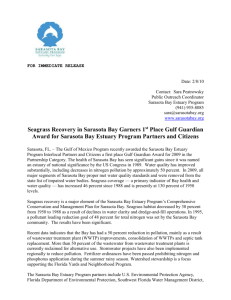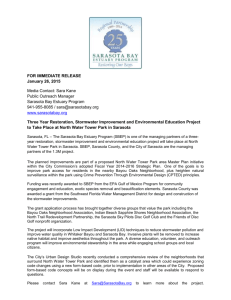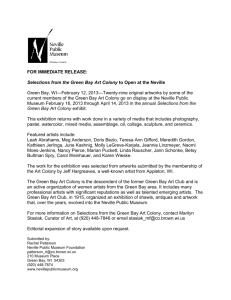Informational Document - Sarasota Bay Estuary Program
advertisement
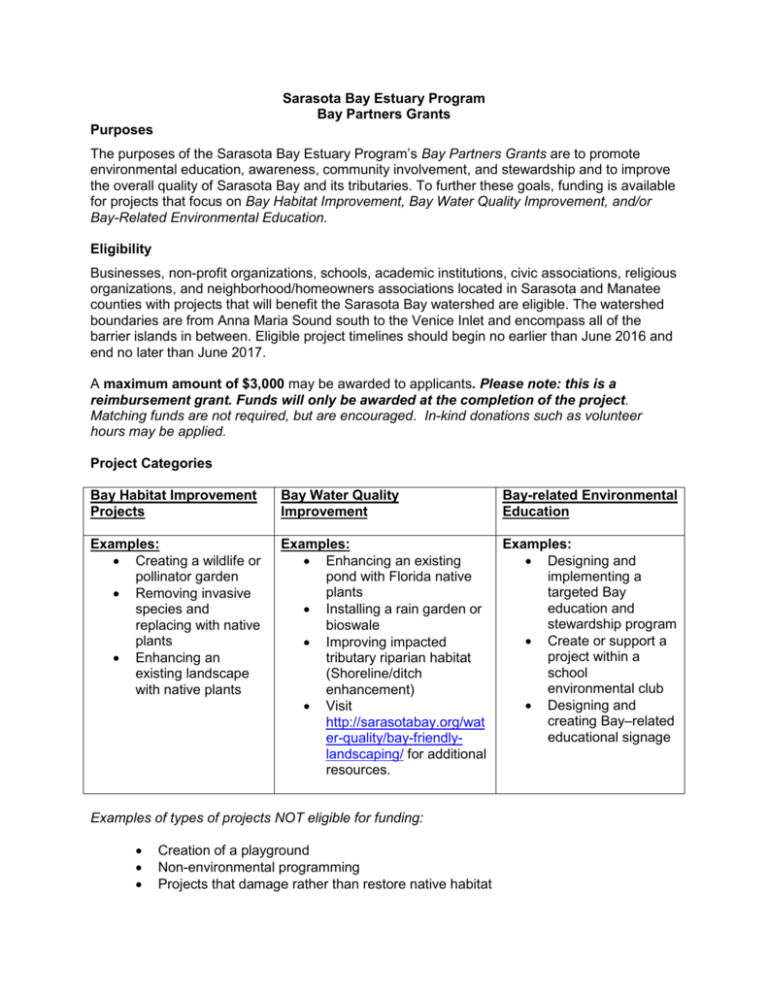
Sarasota Bay Estuary Program Bay Partners Grants Purposes The purposes of the Sarasota Bay Estuary Program’s Bay Partners Grants are to promote environmental education, awareness, community involvement, and stewardship and to improve the overall quality of Sarasota Bay and its tributaries. To further these goals, funding is available for projects that focus on Bay Habitat Improvement, Bay Water Quality Improvement, and/or Bay-Related Environmental Education. Eligibility Businesses, non-profit organizations, schools, academic institutions, civic associations, religious organizations, and neighborhood/homeowners associations located in Sarasota and Manatee counties with projects that will benefit the Sarasota Bay watershed are eligible. The watershed boundaries are from Anna Maria Sound south to the Venice Inlet and encompass all of the barrier islands in between. Eligible project timelines should begin no earlier than June 2016 and end no later than June 2017. A maximum amount of $3,000 may be awarded to applicants. Please note: this is a reimbursement grant. Funds will only be awarded at the completion of the project. Matching funds are not required, but are encouraged. In-kind donations such as volunteer hours may be applied. Project Categories Bay Habitat Improvement Projects Bay Water Quality Improvement Bay-related Environmental Education Examples: Creating a wildlife or pollinator garden Removing invasive species and replacing with native plants Enhancing an existing landscape with native plants Examples: Enhancing an existing pond with Florida native plants Installing a rain garden or bioswale Improving impacted tributary riparian habitat (Shoreline/ditch enhancement) Visit http://sarasotabay.org/wat er-quality/bay-friendlylandscaping/ for additional resources. Examples: Designing and implementing a targeted Bay education and stewardship program Create or support a project within a school environmental club Designing and creating Bay–related educational signage Examples of types of projects NOT eligible for funding: Creation of a playground Non-environmental programming Projects that damage rather than restore native habitat Adding or repairing walls, fish ponds, swimming pools, patios, decks, benches, light fixtures, road signs, or any other non-natural feature of the neighborhood Projects related to compliance, regulation, code enforcement or penalties Projects that use invasive plant species identified on the 2015 FLEPPC plant list: http://www.fleppc.org/list/list.htm Grant Selection Process The Sarasota Bay Estuary Program’s grants review committee will review the applications using the criteria below. Applicants will be notified about review committee decisions in June 2016. Selection Criteria Each applicant can earn a maximum of 100 points. Scores will be determined by totaling the points earned. Funds will be allocated based on scores. Applicants may receive partial funding. Scores, comments and recommendations from the Grant Review Committee will be available for review upon request. Scoring categories are as follows: Project Description (10 points) Does the proposal meet the description of one or more of the three project categories? How well does the application describe the project and its goals? Ecological Benefit (40 points) Is the project environmentally sound? Does the project incorporate benefits to wildlife? If the project aims to alter existing habitat, does the applicant provide evidence that their organization possesses or will be advised by others with the mastery and knowledge necessary to make the alterations? If maintenance will be required past the scope of the Bay Partners Grant, is a plausible maintenance plan described? Community Involvement (30 points) Does the application show evidence of providing benefit for the community? Does the project fill a community need? Does the project have potential to strengthen the community? Does the project promote environmental awareness and stewardship? Will the community be involved in the implementation? If not, is another community involvement activity identified (i.e. open house)? Leveraging (10 points) To what degree has the project received a commitment of funds by another granting organization or internal resources? Budget Proposal (10 points) Does the application include a line item budget describing all estimated expenditures, all sources and amounts of funding, and a proposed spending schedule? Are the budget revenues and expenses clear and justifiable? Is the funding source appropriate? Do the supplies and labor listed as expenditures for this application meet the criteria for acceptable project costs (see below)? Note: Previous grant recipients are eligible to apply; however, new project ideas will be preferred to continuation projects. Applicants may submit only one grant request per grant cycle. Project Costs Allowed Costs: 1. Administration costs - Accounting, bookkeeping, printing, reproduction, postage, shipping, rental of office space (at comparable rates), insurance, indirect costs (limited to 5% of costs of labor), phone costs (solely related to grant work). 2. Professional services – Hourly, with invoice of rate and work accomplished. 3. Materials, plants and supplies – As necessary to carry out the work of the grant (actual price after discounts, rebates or special offers). 4. Equipment – Rental only for sole use of grant work; maintenance and repair only to keep in operating order for life of grant. Purchasing of equipment only in certain circumstances detailed in application and decided upon by Grant Review Committee. 5. Meetings and Conferences – Hosting (only if clearly defined in grant). Attendance costs are not allowed without prior written permission and then only for presentations of information relating to grant work. 6. Reference Materials – If related to grant work. Must be available for public access. 7. All costs must result from work performed solely for the grant. The grant recipient must provide any needed equipment and property in order to complete the work of the grant. This is a reimbursement grant. The following costs are NOT allowed: Memberships, computer software, hardware and supplies; contingency funds, contributions and donations, depreciation, entertainment, food, drinks, gifts, regulations, code enforcements, fines and penalties, bad debts, interest and financial costs of borrowing, pre-payments, legislative expenses, payment to association members, unexpended funds, and attendance at conferences and meetings (unless prior written permission is obtained). Responsibilities of Grant Applicant (prior to/included with application) Permitting compliance. It is the responsibility of the Bay Partners Grant applicant to ensure all required permits are obtained prior to initiating the project. The project must comply with all applicable federal, state and local codes. If unsure whether or not the project requires a permit, contact the relevant city or county public works, environmental services or building departments. Grants will not be approved without proper permits. Sarasota Bay Estuary Program will not be held responsible for work done in association with Bay Partners Grants that do not have proper permits. Permissions. If the project involves use of any parks or preserves, the applicant must obtain permission from the appropriate land management agency to utilize the park or preserve in the project and submit the permission in writing as part of the grant application. Qualifications. Please include the qualifications of the applicant(s), project manager(s), contractor(s) (where applicable), designers (where applicable) and other professionals responsible for ensuring the project meets project purposes. Responsibilities of Grant Awardee (after receiving award letter) See Appendix II Application Submission Details Please email your application in one PDF document to Elizabeth Silleck at elizabeth@sarasotabay.org and cc info@sarasotabay.org by 4:00 pm on Wednesday, March 2nd, 2016. Please use the subject line “Bay Partners Grant Application” and include the name of your organization in the subject line. Alternatively, you may submit a hard copy to: Sarasota Bay Estuary Program Attn: Elizabeth Silleck 111 South Orange Avenue, Suite 200W Sarasota, Florida 34236 For more information: . Public Outreach Manager Elizabeth Silleck elizabeth@sarasotabay.org Appendix I Suggested Invoice Format Current Date To: Sarasota Bay Estuary Program Bay Partners Grant 111 South Orange Avenue, Suite 200W Sarasota, FL 34236 From: Organization name (as it appears on W-9) Organization address (as it appears on W-9) INVOICE Name of items purchased: Cost of items purchased: $ Total cost to be reimbursed: $ Appendix II Responsibilities of Grant Awardee (post-award letter) Community engagement. Grant awardees must demonstrate community involvement and education as part of their proposed project. If appropriate, your project may involve a volunteer effort of your neighbors or cohorts. If your project cannot directly involve volunteers or community involvement you must organize and implement a community education and involvement event based on a key component of the project category. For example, you may coordinate and implement an open house or a project-relevant education event in your neighborhood, project area or other public location. Documentation of the public involvement event must be included in the final report. Acknowledgement. Any publications, media coverage, signage or advertisement associated with the grant project must give funding/sponsor credit to the Sarasota Bay Estuary Program. Please contact the SBEP office to request a digital file of our logo. Project deadline. Projects must be completed within 12 months from award letter date. Costs/expenditures. Costs of the project exceeding the grant award amount are the responsibility of the applicant. Notice of inability to complete project. If unforeseeable circumstances (including but not limited to hurricanes and other disasters) change the nature or scope of the work described in the grant and agreed upon when awarded, it is the responsibility of the grant awardee to contact SBEP to determine whether the grant monies can still be used in the project. Severe changes in the scope of work may require additional documentation, review by the Grant Review Committee, encouragement to apply again next year or even denial of revised proposal. *Please note: All publications, artwork, reports, creative works, or other products produced using Bay Partners Grants funding can be used by the Sarasota Bay Estuary Program at any time. Final Evaluation of Project for Reimbursement In order to receive reimbursement in accordance with the Bay Partners Grants Award Letter, the grant awardee must submit: 1. A Final Report; and 2. An invoice. Final Report Content – The final report must include: 1) a detailed description of work completed, 2) names and titles of parties or individuals who were involved in the work, 3) description of how the final project met the goals outlined in the application, 4) list of community benefits achieved by the project, 5) documentation of successful community involvement and education (including, if applicable, documentation of volunteer hours), and 6) photographs of the completed project. Payment Details In order to process payment, SBEP must have on file, a: Completed W-9 form for your organization Financial statement (where applicable) Final report, including items 1-6 above in “Final Report” description Post-Project Submission Details 1 Please submit Final Report and Invoice 1FROM GRANTEE as a separate attachment in PDF form to: Elizabeth Silleck at Elizabeth@sarasotabay.org and cc info@sarasotabay.org. Please use the Subject Line Format: Bay Partners Grant Final Report and Invoice [Your Organization] Final Report and Invoice must be submitted WITHIN 12 MONTHS after the date of the Bay Partners Grant award letter. Grant awardees must be listed as the payee on the invoice. Invoices submitted from a contractor on behalf of the grant awardee will not be paid. It is the responsibility of the grant awardee to pay any contractors or vendors for services rendered in association with the project.


![[Company Name] Certificate of Completion](http://s2.studylib.net/store/data/005402466_1-8a11f4ced01fd5876feee99f8d8e6494-300x300.png)
